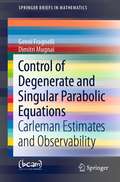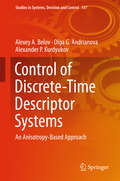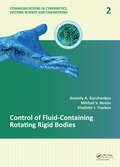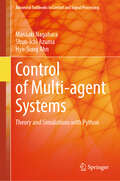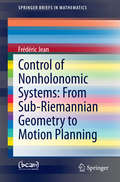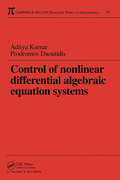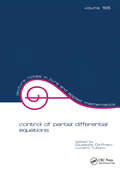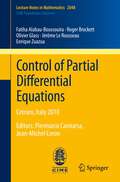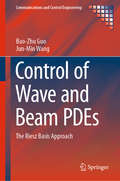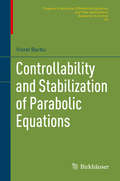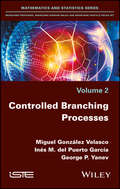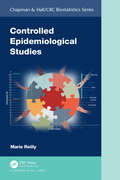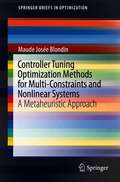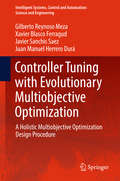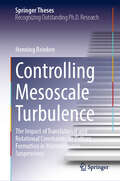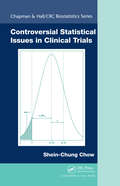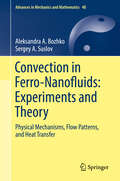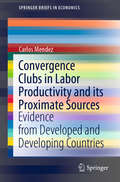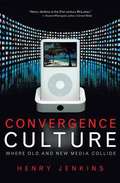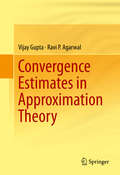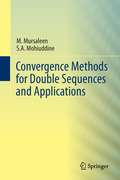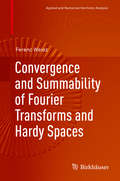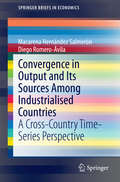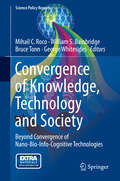- Table View
- List View
Control of Degenerate and Singular Parabolic Equations: Carleman Estimates and Observability (SpringerBriefs in Mathematics)
by Genni Fragnelli Dimitri MugnaiThis book collects some basic results on the null controllability for degenerate and singular parabolic problems. It aims to provide postgraduate students and senior researchers with a useful text, where they can find the desired statements and the related bibliography. For these reasons, the authors will not give all the detailed proofs of the given theorems, but just some of them, in order to show the underlying strategy in this area.
Control of Discrete-Time Descriptor Systems: An Anisotropy-based Approach (Studies In Systems, Decision And Control #157)
by Alexey A. Belov Olga G. Andrianova Alexander P. KurdyukovControl of Discrete-Time Descriptor Systems takes an anisotropy-based approach to the explanation of random input disturbance with an information-theoretic representation. It describes the random input signal more precisely, and the anisotropic norm minimization included in the book enables readers to tune their controllers better through the mathematical methods provided. The book contains numerous examples of practical applications of descriptor systems in various fields, from robotics to economics, and presents an information-theoretic approach to the mathematical description of coloured noise. Anisotropy-based analysis and design for descriptor systems is supplied along with proofs of basic statements, which help readers to understand the algorithms proposed, and to undertake their own numerical simulations. This book serves as a source of ideas for academic researchers and postgraduate students working in the control of discrete-time systems. The control design procedures outlined are numerically effective and easily implementable in MATLAB®
Control of Fluid-Containing Rotating Rigid Bodies (Communications in Cybernetics, Systems Science and Engineering)
by Anatoly A. Gurchenkov Mikhail V. Nosov Vladimir I. TsurkovThis book is devoted to the study of the dynamics of rotating bodies with cavities containing liquid. Two basic classes of motions are analyzed: rotation and libration. Cases of complete and partial filling of cavities with ideal liquid and complete filling with viscous liquid are treated. The volume presents a method for obtaining relations betwee
Control of Multi-agent Systems: Theory and Simulations with Python (Advanced Textbooks in Control and Signal Processing)
by Hyo-Sung Ahn Shun-Ichi Azuma Masaaki NagaharaThis textbook teaches control theory for multi-agent systems. Readers will learn the basics of linear algebra and graph theory, which are then developed to describe and solve multi-agent control problems. The authors address important and fundamental problems including: • consensus control; • coverage control; • formation control; • distributed optimization; and • the viral spreading phenomenon. Students' understanding of the core theory for multi-agent control is enhanced through worked examples and programs in the popular Python language. End-of-chapter exercises are provided to help assess learning progress. Instructors who adopt the book for their courses can download a solutions manual and the figures in the book for lecture slides. Additionally, the Python programs are available for download and can be used for experiments by students in advanced undergraduate or graduate courses based on this text. The broad spectrum of applications relevant to this material includes the Internet of Things, cyber-physical systems, robot swarms, communications networks, smart grids, and truck platooning. Additionally, in the spheres of social science and public health, it applies to opinion dynamics and the spreading of viruses in social networks. Students interested in learning about such applications, or in pursuing further research in multi-agent systems from a theoretical perspective, will find much to gain from Control of Multi-agent Systems. Instructors wishing to teach the subject will also find it beneficial.
Control of Nonholonomic Systems: From Sub-riemannian Geometry To Motion Planning (SpringerBriefs in Mathematics)
by Frédéric JeanNonholonomic systems are control systems which depend linearly on the control. Their underlying geometry is the sub-Riemannian geometry, which plays for these systems the same role as Euclidean geometry does for linear systems. In particular the usual notions of approximations at the first order, that are essential for control purposes, have to be defined in terms of this geometry. The aim of these notes is to present these notions of approximation and their application to the motion planning problem for nonholonomic systems.
Control of Nonlinear Differential Algebraic Equation Systems with Applications to Chemical Processes (Chapman And Hall/crc Research Notes In Mathematics Ser. #397)
by Aditya KumarThe feedback control of nonlinear differential and algebraic equation systems (DAEs) is a relatively new subject. Developing steadily over the last few years, it has generated growing interest inspired by its engineering applications and by advances in the feedback control of nonlinear ordinary differential equations (ODEs). This book-the first of its kind-introduces the reader to the inherent characteristics of nonlinear DAE systems and the methods used to address their control, then discusses the significance of DAE systems to the modeling and control of chemical processes. Within a unified framework, Control of Nonlinear Differential Algebraic Equation Systems presents recent results on the stabilization, output tracking, and disturbance elimination for a large class of nonlinear DAE systems. Written at a basic mathematical level-assuming some familiarity with analysis and control of nonlinear ODEs-the authors focus on continuous-time systems of differential and algebraic equations in semi-explicit form. Beginning with background material about DAE systems and their differences from ODE systems, the book discusses generic classes of chemical processes, feedback control of regular and non-regular DAE systems, control of systems with disturbance inputs, the connection of the DAE systems considered with singularly perturbed systems, and finally offers examples that illustrate the application of control methods and the advantages of using high-index DAE models as the basis for controller design.Mathematicians and engineers will find that this book provides unique, timely results that also clearly documents the relevance of DAE systems to chemical processes.
Control of Partial Differential Equations (Lecture Notes in Pure and Applied Mathematics)
by Giuseppe Da Prato Luciano TubaroThis useful reference provides recent results as well as entirely new material on control problems for partial differential equations.
Control of Partial Differential Equations: Cetraro, Italy 2010, Editors: Piermarco Cannarsa, Jean-Michel Coron (Lecture Notes in Mathematics #2048)
by Enrique Zuazua Jérôme Le Rousseau Roger Brockett Olivier Glass Jean-Michel Coron Fatiha Alabau-Boussouira Piermarco CannarsaThe term "control theory" refers to the body of results - theoretical, numerical and algorithmic - which have been developed to influence the evolution of the state of a given system in order to meet a prescribed performance criterion. Systems of interest to control theory may be of very different natures. This monograph is concerned with models that can be described by partial differential equations of evolution. It contains five major contributions and is connected to the CIME Course on Control of Partial Differential Equations that took place in Cetraro (CS, Italy), July 19 - 23, 2010. Specifically, it covers the stabilization of evolution equations, control of the Liouville equation, control in fluid mechanics, control and numerics for the wave equation, and Carleman estimates for elliptic and parabolic equations with application to control. We are confident this work will provide an authoritative reference work for all scientists who are interested in this field, representing at the same time a friendly introduction to, and an updated account of, some of the most active trends in current research.
Control of Wave and Beam PDEs: The Riesz Basis Approach (Communications and Control Engineering)
by Bao-Zhu Guo Jun-Min WangControl of Wave and Beam PDEs is a concise, self-contained introduction to Riesz bases in Hilbert space and their applications to control systems described by partial differential equations (PDEs). The authors discuss classes of systems that satisfy the spectral determined growth condition, the problem of stability, and the relationship between fulfillment of the condition and stability. Using the (fundamental) Riesz-basis property, the book shows how controllability, observability, stability, etc., can be derived for a linear system. The text provides a crash course in the mathematical theory of Riesz bases so that a reader can quickly understand this powerful method of dealing with linear PDEs. It introduces several important methods for achieving the Riesz basis property through spectral analysis, as well as new approaches including treatment of systems coupled through boundary weak connections. The book moves from a discussion of mathematical preliminaries through bases in Hilbert Spaces to applications to Euler–Bernoulli and Rayleigh beam equations and hybrid systems. The final chapter expands the use of the book’s methods to applications in other systems. Many typical examples, representing physical systems, are discussed in the text. The book is suitable not only for applied mathematicians seeking a powerful tool to understand control systems, but also for control engineers interested in the mathematics of PDE systems.
Controllability and Stabilization of Parabolic Equations (Progress in Nonlinear Differential Equations and Their Applications #90)
by Viorel BarbuThis monograph presents controllability and stabilization methods in control theory that solve parabolic boundary value problems. Starting from foundational questions on Carleman inequalities for linear parabolic equations, the author addresses the controllability of parabolic equations on a variety of domains and the spectral decomposition technique for representing them. This method is, in fact, designed for use in a wider class of parabolic systems that include the heat and diffusion equations. Later chapters develop another process that employs stabilizing feedback controllers with a finite number of unstable modes, with special attention given to its use in the boundary stabilization of Navier–Stokes equations for the motion of viscous fluid. In turn, these applied methods are used to explore related topics like the exact controllability of stochastic parabolic equations with linear multiplicative noise. Intended for graduate students and researchers working on control problems involving nonlinear differential equations, Controllability and Stabilization of Parabolic Equations is the distillation of years of lectures and research. With a minimum of preliminaries, the book leaps into its applications for control theory with both concrete examples and accessible solutions to problems in stabilization and controllability that are still areas of current research.
Controlled Branching Processes
by Miguel González Velasco Inés María Del Puerto García George Petrov YanevThe purpose of this book is to provide a comprehensive discussion of the available results for discrete time branching processes with random control functions. The independence of individuals’ reproduction is a fundamental assumption in the classical branching processes. Alternatively, the controlled branching processes (CBPs) allow the number of reproductive individuals in one generation to decrease or increase depending on the size of the previous generation. Generating a wide range of behaviors, the CBPs have been successfully used as modeling tools in diverse areas of applications.
Controlled Epidemiological Studies (Chapman & Hall/CRC Biostatistics Series)
by Marie ReillyThis book covers classic epidemiological designs that use a reference/control group, including case-control, case-cohort, nested case-control and variations of these designs, such as stratified and two-stage designs. It presents a unified view of these sampling designs as representations of an underlying cohort or target population of interest. This enables various extended designs to be introduced and analysed with a similar approach: extreme sampling on the outcome (extreme case-control design) or on the exposure (exposure-enriched, exposure-density, countermatched), designs that re-use prior controls and augmentation sampling designs. Further extensions exploit aggregate data for efficient cluster sampling, accommodate time-varying exposures and combine matched and unmatched controls. Self-controlled designs, including case-crossover, self-controlled case series and exposure-crossover, are also presented. The test-negative design for vaccine studies and the use of negative controls for bias assessment are introduced and discussed. This book is intended for graduate students in biostatistics, epidemiology and related disciplines, or for health researchers and data analysts interested in extending their knowledge of study design and data analysis skills. This book Bridges the gap between epidemiology and the more mathematically oriented biostatistics books. Assembles the wealth of epidemiological knowledge about observational study designs that is scattered over several decades of scientific publications. Illustrates the performance of methods in real research applications. Provides guidelines for implementation in standard software packages (Stata, R). Includes numerous exercises, covering simple mathematical proofs, consideration of proposed or published designs, and practical data analysis.
Controller Tuning Optimization Methods for Multi-Constraints and Nonlinear Systems: A Metaheuristic Approach (SpringerBriefs in Optimization)
by Maude Josée BlondinThis book covers controller tuning techniques from conventional to new optimization methods for diverse control engineering applications. Classical controller tuning approaches are presented with real-world challenges faced in control engineering. Current developments in applying optimization techniques to controller tuning are explained. Case studies of optimization algorithms applied to controller tuning dealing with nonlinearities and limitations like the inverted pendulum and the automatic voltage regulator are presented with performance comparisons. Students and researchers in engineering and optimization interested in optimization methods for controller tuning will utilize this book to apply optimization algorithms to controller tuning, to choose the most suitable optimization algorithm for a specific application, and to develop new optimization techniques for controller tuning.
Controller Tuning with Evolutionary Multiobjective Optimization: A Holistic Multiobjective Optimization Design Procedure (Intelligent Systems, Control and Automation: Science and Engineering #85)
by Gilberto Reynoso Meza Xavier Blasco Ferragud Javier Sanchis Saez Juan Manuel Herrero DuráThis book is devoted to Multiobjective Optimization Design (MOOD) procedures for controller tuning applications, by means of Evolutionary Multiobjective Optimization (EMO). It presents developments in tools, procedures and guidelines to facilitate this process, covering the three fundamental steps in the procedure: problem definition, optimization and decision-making. The book is divided into four parts. The first part, Fundamentals, focuses on the necessary theoretical background and provides specific tools for practitioners. The second part, Basics, examines a range of basic examples regarding the MOOD procedure for controller tuning, while the third part, Benchmarking, demonstrates how the MOOD procedure can be employed in several control engineering problems. The fourth part, Applications, is dedicated to implementing the MOOD procedure for controller tuning in real processes.
Controlling Mesoscale Turbulence: The Impact of Translational and Rotational Constraints on Pattern Formation in Microswimmer Suspensions (Springer Theses)
by Henning ReinkenThis thesis combines methods from statistical physics and nonlinear dynamics to advance research on the pattern formation in active fluids in several directions. In particular, it focuses on mesoscale turbulence, a state observed in microswimmer suspensions, which is characterized by the emergence of dynamic vortex patterns. The first major contribution concerns the bottom-up derivation of a frequently used continuum model of mesoscale turbulence from a set of particle-resolved stochastic equations. Utilizing the model, mesoscale turbulence is shown to induce nontrivial transport properties including a regime of optimal diffusion. The thesis then explores possible strategies of control. One of these relies on an external field that leads to stripe-like structures and can even suppress patterns entirely. The other involves geometric confinement realized by strategically placed obstacles that can reorganize the flow into a variety of ordered vortex structures. The turbulence transition inside an obstacle lattice is shown to have an intriguing analogy to an equilibrium transition in the Ising universality class. As a whole, this thesis provides important contributions to the understanding and control of turbulence in active fluids, as well as outlining exciting future directions, including applications. It includes a substantial introduction to the topic, which is suitable for newcomers to the field.
Controlling the Effective Hamiltonian of a Driven Quantum Superconducting Circuit (Springer Theses)
by Jayameenakshi VenkatramanThe thesis illustrates, with a remarkable combination of theoretical analysis and experimental investigation, how the static Hamiltonian of an oscillator with both 3rd and 4th order non-linearity can morph into a profoundly different Hamiltonian under the influence of an oscillating driving force. In a classical system, such transformation would not be considered a novelty, but the author demonstrates that the new Hamiltonian can possess an exotic symmetry with surprising new quantum properties that one would never anticipate from the original Hamiltonian, with no classical equivalent. The root cause of these unexpected properties is a subtle interference effect, which is only possible in a quantum context. Carefully crafted control experiments ensure that measured data are compared with theoretical predictions with no adjustable parameters. Instrumental in this comparison is a new diagrammatic theory developed by the author.
Controversial Statistical Issues in Clinical Trials (Chapman & Hall/CRC Biostatistics Series)
by Shein-Chung ChowIn clinical trial practice, controversial statistical issues inevitably occur regardless of the compliance with good statistical practice and good clinical practice. But by identifying the causes of the issues and correcting them, the study objectives of clinical trials can be better achieved. Controversial Statistical Issues in Clinical Trials cov
Convection in Ferro-Nanofluids: Physical Mechanisms, Flow Patterns, and Heat Transfer (Advances in Mechanics and Mathematics #40)
by Aleksandra A. Bozhko Sergey A. SuslovThis book covers the experimental and theoretical study of convection in non-isothermal ferro-nanofluids (FNFs). Since FNFs are not transparent and magnetic fields are very sensitive to the shape of the boundary between magnetic and nonmagnetic media, special flow visualization techniques based on the use of thermo-sensitive liquid crystal films, infrared cameras, as well as local and integral temperature sensors are discussed in the book. This book considers several major configurations of convective chambers and the applied magnetic field. For each of them, the stability boundaries are determined theoretically and experimentally. The physical types of dominant instabilities and the characteristics of their interactions are subsequently established using linear and weakly non-linear hydrodynamic stability analyses and elements of bifurcation theory. The book also discusses the potential of using magnetically controlled ferro-nanofluids as a heat carrier in situations where heat removal by natural convection is not possible due to the lack of gravity (orbital stations) or extreme confinement (microelectronics). Researchers and practitioners working in the areas of fluid mechanics, hydrodynamic stability, and heat and mass transfer will benefit from this book.
Convergence Clubs in Labor Productivity and its Proximate Sources: Evidence from Developed and Developing Countries (SpringerBriefs in Economics)
by Carlos MendezTesting for economic convergence across countries has been a central issue in the literature of economic growth and development. This book introduces a modern framework to study the cross-country convergence dynamics in labor productivity and its proximate sources: capital accumulation and aggregate efficiency. In particular, recent convergence dynamics of developed as well as developing countries are evaluated through the lens of a non-linear dynamic factor model and a clustering algorithm for panel data. This framework allows us to examine key economic phenomena such as technological heterogeneity and multiple equilibria. In this context, the book provides a succinct review of the recent club convergence literature, a comparative view of developed and developing countries, and a tutorial on how to implement the club convergence framework in the statistical software Stata.
Convergence Culture: Where Old and New Media Collide
by Henry JenkinsI thought I knew twenty-first century pop media until I read Henry Jenkins. The fresh research and radical insights in Convergence Culture deserve a wide and thoughtful readership. Bring on the monolithic block of eyeballs! -Bruce Sterling, author, blogger, visionary. Henry Jenkins offers crucial insight into an unexpected and unforeseen future. Unlike most predictions about how New Media will shape the world in which we live, the reality is turning out far stranger and more interesting than we might have imagined. The social implications of this change could be staggering. -Will Wright, designer of SimCity and The Sims. One of those rare works that is closer to an operating system than a traditional book: it's a platform that people will be building on for years to come. What's more, the book happens to be a briskly entertaining read-as startling, inventive, and witty as the culture it documents. It should be mandatory reading for anyone trying to make sense of today's popular culture but thankfully, a book this fun to read doesn't need a mandate. -Steven Johnson, author of the national bestseller, Everything Bad Is Good For You. Henry Jenkins is the 21st century McLuhan I've been waiting for. With all the fuzzy generalities, moral panics, and gloomy pronouncements from industry spokesmen and social critics, Jenkins' clearly communicated and nuanced analysis is sorely needed. The world McLuhan foretold back in the age of 'electric media' has become immensely more complicated in today's many-to-many, converged, remixed and mashed-up, digital, mobile, always-on media environment. If you are a parent, a student, an educator, a creator or consumer of popular culture, an entrepreneur, or a media industry executive, you need to understand convergence culture. And you will only after reading Henry Jenkins.-Howard Rheingold, author of Smart Mobs: The Next Social Revolution. I simply could not put this book down! Henry Jenkins provides a fascinating account of how new media intersects old media and engages the imagination of fans in more and more powerful ways. Educators, media specialists, policy makers and parents will find Convergence Culture both lively and enlightening.-John Seely Brown, Former Chief Scientist, Xerox Corp & director of Xerox PARC. Convergence Culture maps a new territory: where old and new media intersect, where grassroots and corporate media collide, where the power of the media producer and the power of the consumer interact in unpredictable ways. Henry Jenkins, one of America's most respected media analysts, delves beneath the new media hype to uncover the important cultural transformations that are taking place as media converge. He takes us into the secret world of Survivor Spoilers, where avid internet users pool their knowledge to unearth the show's secrets before they are revealed on the air. He introduces us to young Harry Potter fans who are writing their own Hogwarts tales while executives at Warner Brothers struggle for control of their franchise. He shows us how The Matrix has pushed transmedia storytelling to new levels, creating a fictional world where consumers track down bits of the story across multiple media channels. Jenkins argues that struggles over convergence will redefine the face of American popular culture. Industry leaders see opportunities to direct content across many channels to increase revenue and broaden markets. At the same time, consumers envision a liberated public sphere, free of network controls, in a decentralized media environment. Sometimes corporate and grassroots efforts reinforce each other, creating closer, more rewarding relations between media producers and consumers. Sometimes these two forces are at war.
Convergence Estimates in Approximation Theory
by Ravi P. Agarwal Vijay GuptaThe study of linear positive operators is an area of mathematical studies with significant relevance to studies of computer-aided geometric design, numerical analysis, and differential equations. This book focuses on the convergence of linear positive operators in real and complex domains. The theoretical aspects of these operators have been an active area of research over the past few decades. In this volume, authors Gupta and Agarwal explore new and more efficient methods of applying this research to studies in Optimization and Analysis. The text will be of interest to upper-level students seeking an introduction to the field and to researchers developing innovative approaches.
Convergence Methods for Double Sequences and Applications
by M. Mursaleen S. A. MohiuddineThis book exclusively deals with the study of almost convergence and statistical convergence of double sequences. The notion of "almost convergence" is perhaps the most useful notion in order to obtain a weak limit of a bounded non-convergent sequence. There is another notion of convergence known as the "statistical convergence", introduced by H. Fast, which is an extension of the usual concept of sequential limits. This concept arises as an example of "convergence in density" which is also studied as a summability method. Even unbounded sequences can be dealt with by using this method. The book also discusses the applications of these non-matrix methods in approximation theory. Written in a self-contained style, the book discusses in detail the methods of almost convergence and statistical convergence for double sequences along with applications and suitable examples. The last chapter is devoted to the study convergence of double series and describes various convergence tests analogous to those of single sequences. In addition to applications in approximation theory, the results are expected to find application in many other areas of pure and applied mathematics such as mathematical analysis, probability, fixed point theory and statistics.
Convergence and Summability of Fourier Transforms and Hardy Spaces (Applied and Numerical Harmonic Analysis)
by Ferenc WeiszThe main purpose is to investigate the convergence and summability both of one-dimensional and multi-dimensional Fourier transforms as well as the theory of Hardy spaces. A general summability method, the so called theta-summation, is studied which contains all well known summability methods, such as the Fej#65533;r, Riesz, Weierstrass, Abel, Picard, Bessel and Rogosinski summations. After the classical books of Bary (1964) and Zygmund (1968), this is the first book which considers strong summability treated by current methods. A further novelty of this book is that the Lebesgue points are studied also in the theory of multi-dimensional summability. Besides the classical results, recent results of the last 20-30 years are studied. These results can be found in different research papers the summary of which in a unified context provides the readers a valuable support in their work. The book will be useful for researchers as well as for graduate or postgraduate students. The first two chapters can be used by graduate students and the other ones by PhD students and researchers.
Convergence in Output and Its Sources Among Industrialised Countries: A Cross-Country Time-Series Perspective (SpringerBriefs in Economics)
by Diego Romero-Ávila Macarena Hernández SalmerónThis book investigates the existence of stochastic and deterministic convergence of real output per worker and the sources of output (physical capital per worker, human capital per worker, total factor productivity -TFP- and average annual hours worked) in 21 OECD countries over the period 1970-2011. Towards this end, the authors apply a large battery of panel unit root and stationarity tests, all of which are robust to the presence of cross-sectional dependence. The evidence fails to provide clear-cut evidence of convergence dynamics either in real GDP per worker or in the series of the sources of output. Due to some limitations associated with second-generation panel unit root and stationarity tests, the authors further use the more flexible PANIC approach which provides evidence that real GDP per worker, real physical capital per worker, human capital and average annual hours exhibit some degree of deterministic convergence, whereas TFP series display a high degree of stochastic convergence.
Convergence of Knowledge, Technology and Society: Beyond Convergence of Nano-Bio-Info-Cognitive Technologies (Science Policy Reports)
by Mihail C. Roco William S. Bainbridge Bruce Tonn George WhitesidesThis volume aims to document the most important worldwide accomplishments in converging knowledge and technology, including converging platforms, methods of convergence, societal implications, and governance in the last ten years. Convergence in knowledge, technology, and society is the accelerating, transformative interaction among seemingly distinct scientific disciplines, technologies, and communities to achieve mutual compatibility, synergism, and integration, and through this process to create added value for societal benefit. It is a movement that is recognized by scientists and thought leaders around the world as having the potential to provide far-reaching solutions to many of today's complex knowledge, technology, and human development challenges. Four essential and interdependent convergence platforms of human activity are defined in the first part of this report: nanotechnology-biotechnology-information technology and cognitive science ("NBIC") foundational tools; Earth-scale environmental systems; human-scale activities; and convergence methods for societal-scale activities. The report then presents the main implications of convergence for human physical potential, cognition and communication, productivity and societal outcomes, education and physical infrastructure, sustainability, and innovative and responsible governance. As a whole, the report presents a new model for convergence. To effectively take advantage of this potential, a proactive governance approach is suggested. The study identifies an international opportunity to develop and apply convergence for technological, economic, environmental, and societal benefits. The panel also suggests an opportunity in the United States for implementing a program aimed at focusing disparate R and D energies into a coherent activity - a "Societal Convergence Initiative". This study received input from leading academic, industry, government, and NGO experts from the United States, Latin America, Europe, Asia, and Australia.
